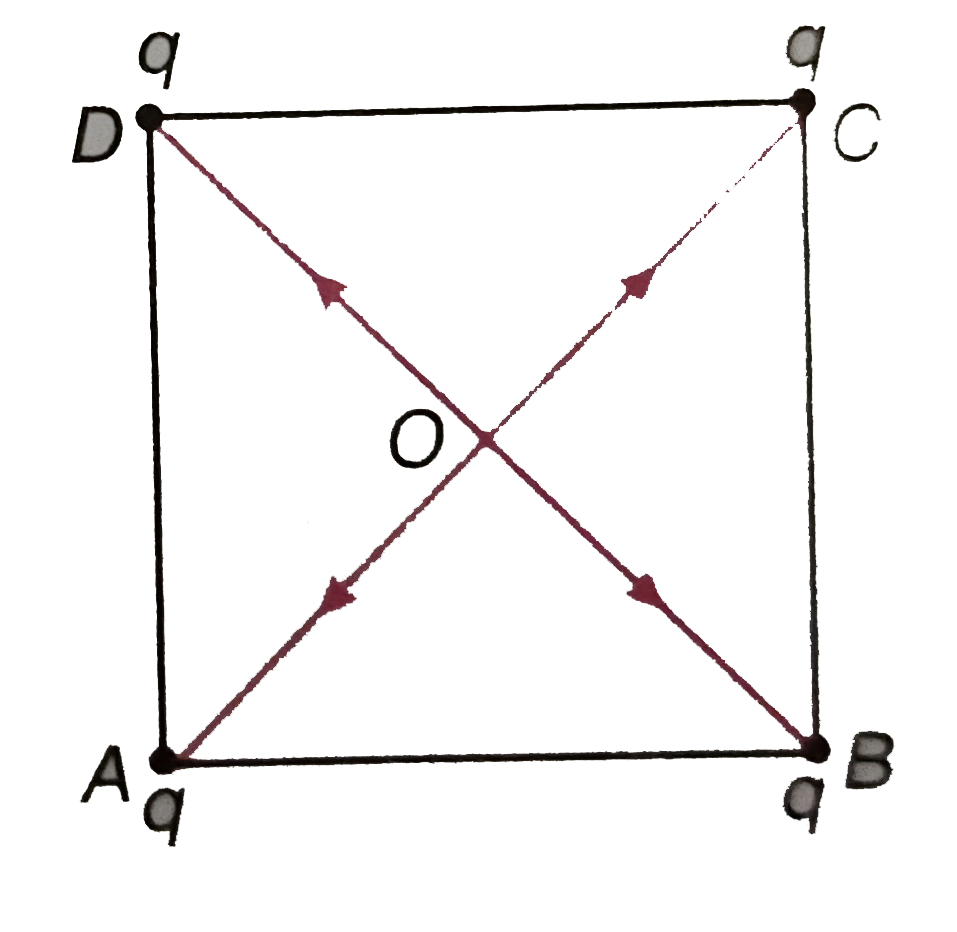In vacuum, four charges each equal to q are placed at each of the four vertices of a square. Find the intensity and potential of the electric field at the point of intersection of two diagonals.Solution in Bengali
Let the length of each side of the square be a. According to the fig.
AC=√AB2+BC2=√a2+a2
=√2a
Now, AC=BD
and AO=BO=CO=Do=12AC
=12⋅√2a=a√2
Therefore, intensity at O due to the change q at A is given by
E1=14πε0⋅q(a√2)2,along−−→OC
Intensity at O due to the charge at C is given by
E2=14πε0⋅q(a√2)2,along−−→OA
These two intensities being equal and opposite balance each other.
Similarly, intensities at O due to the charges at B and D being equal and opposite balance each other. So the intensity at the point of intersection of the two diagonals is zero.
Potential at O = 14πε0⋅⎡⎢⎣qa√2+qa√2+qa√2+qa√2⎤⎥⎦=4√2q4πε0a

Topper's Solved these Questions
- BOOK - CHHAYA PUBLICATIONCHAPTER - ELECTRIC POTENTIAL EXERCISE - Section related questions25videos
ELECTRIC POTENTIAL
- BOOK - CHHAYA PUBLICATIONCHAPTER - ELECTRIC POTENTIAL EXERCISE - Higher order thinking skill (HOTS) questions23videos
ELECTRIC POTENTIAL
- BOOK - CHHAYA PUBLICATIONCHAPTER - ELECTRIC FIELDEXERCISE - CBSE SCANNER31videos
ELECTRIC FIELD
- BOOK - CHHAYA PUBLICATIONCHAPTER - ELECTROMAGNETIC INDUCTION & ALTERNATING CURRENTEXERCISE - CBSE SCANNER28videos
ELECTROMAGNETIC INDUCTION & ALTERNATING CURRENT
Similar Questions
What do you mean by potential of a charged body?
02:51View SolutionIf the intensity at a point in an electric field is zero, will the electric potential be also zero at that point? If the electric potential be zero at a point, will the intensity be also zero at the point?
07:24View SolutionA charge q is placed at the centre of a cube of side l. What is the electric flux passing through each face of the cube?
06:24View SolutionA bar magnet is moved in the direction indicated by the arrow between two coils PQ and CD. Predict the directions of induced current in each coil.
 09:18View Solution
09:18View SolutionFour idential charges each of charge q are placed at the corners of a square .Then at the centre of the square the resultant electric intensity E and the net electric potential V are
04:04View SolutionFour identical charges, Q each, are fixed at the vertices of a square. A free charge q is placed at the centre of the square. Investigate the nature of equilibrium of charge q if it is to be displaced slightly along any of the two diagonals of the square.
07:31View SolutionFour small point charges (each of equal magnitude q) are placed at four corners of a regular tetrahedron of side a. find out potential energy of charge system
05:47View Solutionएक धन की प्रत्येक कोर a है तथा इसके प्रत्येक शीर्ष पर q आवेश है |धन के केन्द्र पर विभव एवं विद्युत-क्षेत्र की तीव्रता ज्ञात कीजिए |
05:18View SolutionAt each of the four vertices of a square of side 10 cm, four positive charges each of 20 esu are placed. Find the potential at the point of intersection of the two diagonals.
12:13View SolutionIn vacuum, equal charges of the same nature are placed at the vertices of an equilateral triangle. What will be the electric field intensity and potential at the centroid of the triangle?
10:11View SolutionAt each of the four vertices of a square of side 10 cm there is a +20 esu of charge. Find the Intensity of electric fleld at the point of Intersection of the two dlagonals.
04:20View SolutionFour point charges +q,+q,+q and −q are placed at the four comers of a square, length of each side of which is a.
Find the magnitude of the intensity of the electric field at the centre of the square.03:50View SolutionFour point charges +2nC,-3nC,+4nC,-5nC are placed at the vertices A,B,C,D of a square ABCD of side 0.2 m respectively. Calculate the electric field intensity at a point of intersection of the diagonals.
02:22View SolutionFind the electric field and potential at the centre of a square of side d = 10 cm. Four identical charges of q=2muC each are kept at the four corners of a square.
View SolutionFour charges equal to - Q placed at the four corners of a sqare and a charge q is its centre. If the system is in equilibrium, the value of q is
11:08View Solution

